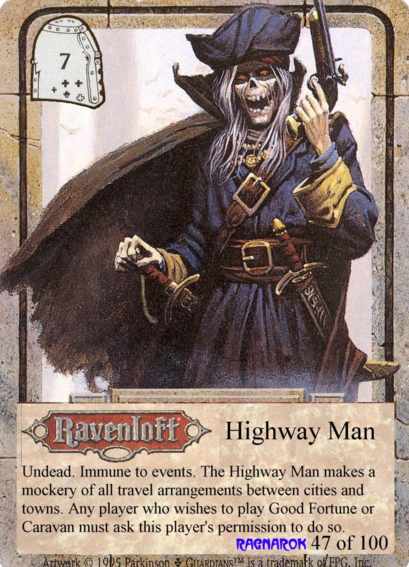The
Bandit
by
Tom Armstrong && Roger E. Moore
The
Bandit
by
Tom Armstrong && Roger E. Moore
| - | - | - | - | - |
| Dragon | Classes | - | Best of Dragon, Vol. IV | Dragon 63 |
1. SUBCLASS =
2. SOCIAL CLASS MINIMUM =
3. ABILITY SCORE MINIMUMS
STRENGTH = 12:16
INTELLIGENCE = 10:16
WISDOM = 6
DEXTERITY = 12:16
CONSTITUTION = 12
CHARISMA = 6
COMELINESS = 3
PERCEPTION = 3
4. XP BONUS =
5. POSSIBLE RACES & MAX. LEVEL ATTAINABLE
= human(U), half-orc, half-elf. N5.37: dwarf, elf, hobbit.
6. MULTI-CLASS POSSIBILITIES =
7. HIT DIE TYPE = d8+1
8. MAXIMUM NUMBER OF HIT DICE = 9
9. SPELL ABILITY = no
10. ARMOR PERMITTED = padded, leather,
studded leather, ring, and chain mail
11. SHIELD PERMITTED =
12. WEAPONS PERMITTED =
13. OIL PERMITTED =
14. POISON PERMITTED =
15. ALIGNMENT =
16. STARTING MONEY =
17. WEAPON PROFICIENCIES =
18. NON-PROFICIENCY PENALTY =
19. NON-WEAPON PROFICIENCIES =
20. STARTING AGE =
21. COMBAT = fighter
22. SAVING THROWS = fighter
23. MAGIC ITEMS =
BANDIT EXPERIENCE LEVEL TABLE
250,000 XP per level for each additional
level above the 12th.
Bandits gain 2 HP per
level after the 9th.
Cover tracks percentage
increases 3% per level to a max. of 98% at 17th level.
Special Abilities
* 1. Bandits can climb walls as a thief
of equal level.
* 2. They can his in natural terrain using
camouflage techniques and concealment as well as a thief of the same level
can hide in shadows.
* (For instance, a half-elf bandit with
Dex of 17 has a 20% chance of hiding in natural terrain at 1st level.)
* 3. Pits, snares, and other traps set outdoors may ne detected and removed by bandits with the same chance for success as a thief of equal level has to find and remove traps.
* 4. Bandits are adept at covering their
tracks when passing through the countryside.
* Then a successful dice roll (equal to
or less than the required percentage) enables the bandit to keep covering
his tracks in this manner for a maximum duration of 1 turn per level of
experience per day.
* Rangers, bounty hunters, or other bandits tracking a bandit who has successfully covered his trail must take a -50% penalty when rolling to see if they can accurately follow a covered trail.
* A character or creature with no particular skill at tracking or with no acute olfactory sense has a 10% chance of correctly following a covered trail (thanks to blind luck) in the first round.
* If that attempt succeeds, the same 10% chance must be rolled in each and every round during which the tracker is attempting to follow the trail.
* Otherwise, the trail is lost and can only be relocated by remaining in the same spot (searching) for one round and then rolling the 10% chance all over again.
* 5. Bandits surprise others on a roll of 1-4 on a six-sided die, and are themselves surprised only onn a roll of 1.
* 6. Bandits can track persons or creatures
in the outdoors as a ranger can, but they have a base 75% chance to succeed.
This percentage increases by 2% per creature
in the group being followed,
decreases by 10% for every 24-hour period
since the trail was made,
and decreases by 25% for each hour that
precipitation (rain, snow, etc.) has fallen on the trail.
* 7. When a bandit is evading pursuit in an outdoor environment (see the DMG, p. 69), 10% is added to the bandit's chance to escape.
Combat and other characteristics
* Bandits get one attack per round until
attaining 8th level, when they can attack three times in two rounds.
* They gain two attacks per round at 15th
level and higher.
* When in combat with 0-level humans or
halflings, or with creatures of less than one HD, a bandit can attack once
per round for each level of experience he has attained.
* The minimum movement rate a bandit will accept is 9", and his armor should weigh 30# or less.
* Bandits will never load their mounts over the encumbered load limit (300# weight for a light warhorse, which is the favorite mount of bandits).
* Henchmen and hirelings of a bandit who are also bandits add +5% to all morale checks.
The Bandit class from Dragon Magazine
Issue number 63, is one of my favorite classes.
Its listed as an NPC class, but, it
is not un-balancing and I have allowed it back in the day in a few of my
OAD&D games.
Here is a copy of the Bandit from said Dragon (by Tom Armstrong and Roger E. Moore):
The Bandit is a non-player-character class
containing aspects of both the fighter and thief classes. Bandits practice
their profession of thievery by orce rather than by stealth, as do normal
thieves. Bandits operate in the open countryside, making them similar in
some ways to rangers. Bandits can (and successful ones do) develop wilderness
survival skills and certain
thief-like abilities to enable them to
further their ends. Bandits are typically involved in highway robbery,
raids on small villages or isolated habitations, kidnapping for ransom,
and similar sorts of activities.
Humans, half-orcs, and half-elves may become bandits. Humans, naturally, are unlimited in level advancement. Half-orcs may advance to 8th level (Brigand). Half-elves may achieve 10th level (Bandit) if they have a STR of 18 or higher, 9th level (Robber) with a strength of 17, and 8th level with a strength of 16 or less.
A bandit must have minimum ability scores
in four areas: strength 12, intelligence 10, dexterity 12, and constitution
12.
Bandits with scores of 16 or higher in
strength, intelligence, and dexterity gain a 10% bonus to all experience
points earned.
Bandits may be of any neutral or evil alignment.
On rare occasions and in special circumstances,
neutral good bandits may be found (in the tradition of Robin Hood), either
as individuals or in small groups. Alignment is a major factor in determining
how a particular bandit or group of bandits operates. Those of neutral
alignment (with respect to good and evil) are most likely to allow their
robbery or kidnap victims to live, preferring to collect their possessions
(or a ransom) and then release them, avoiding a
possible death penalty for murder and
at the same time leaving open the possibility of victimizing the same people
all over again.
Evil bandits have no such reservations
about killing.
Generally, they will take fewer captives
than neutral bandits, unless they are sure that a victim is worth enough
(in ransom) to make the trouble and risk of kidnapping worthwhile.
In such cases, they will usually wait until after the ransom has been paid before killing their victim.
When neutral good bandits are found, this is frequently in the territories of evil kings or dictators, where the bandits attack evil persons and donate the “earnings” to the poor and needy of the area, or to charity (but never to a player character).
Lawful bandits tend to operate in large groups, chaotic ones in small bands or singly. No matter what the size of a group of bandits, the rule is “Leadership by the strongest.”
Bandits roll different hit dice than fighters or thieves, reflecting the fact that, while not as good in close combat as regular fighters, they are better than thieves in such respects. They use an eight-sided die plus one point per level up to 9th level and add 2 hit points per level after the 9th. The hit-point average for a bandit is very close to that of a fighter of equal level, but a bandit’s maximum number of hit points is lower than a fighter’s.
Special abilities:
Bandits have no spell abilities or spell-like
powers, but they do have a combination of seven other sorts of special
abilities:
1. Bandits can climb walls as a thief
of equal level. Bonuses for high dexterity apply.
2. They can hide in natural terrain using
camouflage techniques and concealment as well as a thief of the same level
can hide in shadows. Bonuses for high dexterity and race also apply here.
(For instance, a half-elf bandit with dexterity of 17 has a 20% chance
of hiding in natural terrain at 1st level.) This ability is not usable
indoors or in subterranean environments.
3. Pits, snares and other traps set outdoors
may be detected and removed by bandits with the same chance for success
as a thief of equal level has to find and remove traps. Again, racial and
dexterity bonuses apply to this ability. A bandit may only attempt to find
and remove any given trap once. This ability cannot be used indoors or
underground, and does not apply to traps on chests, doors, etc.
4. Bandits are adept at covering their
tracks when passing through the countryside. In some ways, this ability
is similar to the druidic spell Pass Without Trace; however, the source
of the bandits’ ability is not magical. A first-level bandit has a 50%
chance for success in covering tracks, and that base chance is increased
3% per level thereafter. When this ability is used successfully, the bandit
can pass through any sort of terrain (grass, snow, ash, dust, sand) without
leaving any footprints or other visible evidence of the passage. To make
the ability work, the bandit must first reduce his movement rate to one-half
of his current normal rate. (He is presumed to be taking the time to conceal
or obscure his tracks as he goes.) Then a successful dice roll (equal to
or less than the required percentage) enables the bandit to keep covering
his tracks in this manner for a maximum duration of 1 turn per level of
experience per day. As many attempts as desired can be made each day, as
long as the total elapsed time of all the successful attempts does not
exceed the daily maximum. To discontinue the covering of his tracks, all
a bandit needs to do is resume his full normal movement rate. Each individual
bandit can only employ this ability on his own behalf; in other words,
one cannot cover the tracks of many, and one bandit may be betrayed by
another one’s failure to cover his own tracks if the two are traveling
close together. Although most or all of the visible evidence of his passage
can be covered, the bandit will leave
a scent that can be followed by such creatures as bloodhounds or minotaurs.
Rangers, bounty hunters, or other bandits tracking a bandit who has successfully
covered his trail must take a -50% penalty when rolling to see if they
can accurately follow a covered trail. A character or creature with no
particular skill at tracking or with no acute olfactory sense has a 10%
chance of correctly following a covered trail (thanks to blind luck) in
the first round, and if that attempt succeeds, the same 10% chance must
be rolled in each and every round during which the tracker is attempting
to follow the trail; otherwise, the trail is lost and can only be relocated
by remaining in the same spot (searching) for one round and then rolling
the 10% chance all over again.
5. Bandits surprise others on a roll of
1-4 on a six-sided die,
and are themselves surprised only on a
roll of 1.
6. Bandits can track persons or creatures
in the outdoors as a ranger can, but they have a base 75% chance to succeed.
This percentage increases by 2% per creature in the group being followed,
decreases by 10% for every 24-hour period since the trail was made, and
decreases by 25% for each hour that precipitation (rain, snow, etc.) has
fallen on the trail. Bandits cannot track characters or creatures indoors.
7. When a bandit is evading
pursuit in an outdoor environment (see the AD&D™ DMG, page
69), 10% is added to the bandit’s chance of escape. This does not apply
to any and all non-bandits in the evading party, so it is possible for
the Dungeon Master to determine that, while the party the bandit is with
cannot avoid the posse, the bandit (who is assumed to have dodged into
the underbrush at the last moment) has escaped. This ability applies only
when the bandit is not
already covering his trail.
Combat and other characteristics:
Bandits attack and save as a fighter of
equal level. They attack once per round until attaining 8th level, when
they can attack three times in two rounds. They gain two attacks per round
at 15th level and higher. When in combat with 0-level humanoids or with
creatures of less than one hit die, a bandit can attack once per round
for each level of experience he has attained.
Bandits will use all sorts of missile weapons
(bows, slings, darts, crossbows), but will only use hand-held weapons under
5 feet in length that will not encumber them or be awkward to use in combat.
This excludes all polearms as well as such weapons as two-handed swords
and great axes. Permissible hand-tohand weapons include: the hand and battle
axes, club, dagger, hammer, mace, morning star, military pick, scimitar,
and long, short, and broad swords. Bandits will use magical forms of the
weapons permitted to them. They can employ oil as a weapon, but their use
of poison is up to the Dungeon Master and the
character’s alignment.
Because bandits must be able to move quickly,
they will avoid wearing any armor heavier than chain mail. Acceptable armor
types are: padded, leather, studded leather, ring, and chain mail. Magical
armors of these sorts may be used as well, but bandits will not wear other
types. The minimum movement rate a bandit will accept is 9”, and his armor
should weigh 30 pounds or less. Bandits will not wear great helms or use
large shields, preferring skullcaps or no helm with small shields. Some
have
been known to use medium-sized shields.
Any magic item not prohibited to fighters may be used by bandits, within the restrictions on armor and weapons noted above. However, much as a ranger limits his personal belongings to those his steed can carry, so will a bandit limit his goods to those he and his horse can carry with them.
Excess treasure and/or goods must be gotten
rid of as soon as possible so as not to slow him down. Bandits will never
load their mounts over the
unencumbered load limit (3,000 gp weight
for a light warhorse, the favorite mount of bandits).
A bandit will not build a castle, but may
establish a stronghold in an isolated area. In such a case, the bandit
may retain sufficient treasure to finance construction and upkeep. He/she
will still restrict the number of personal items retained. A bandit may
gain hirelings and/or henchmen at any level. These will never be of good
alignment, except for an occasional
neutral good found in the camp of a non-evil
leader.
Bandits who establish a stronghold will
not automatically attract a body of men-at-arms as do normal fighters,
but they are free to hire men-at-arms on their own as desired. Bandits
do not receive a revenue from the inhabitants surrounding their stronghold,
either, though this does not preclude the possibility of raiding or extorting
the locals. Henchmen && hirelings of a bandit who are also bandits
add +5% to all morale checks.
Bandits tend to worship deities who are involved with the outdoors, thieves, luck, or the weather.
ROGUES' GALLERY: BANDITS
zb
8. Korska Kellukuscha (bandit 14; 92.319)
7. Grank (NE hm C3)

6.
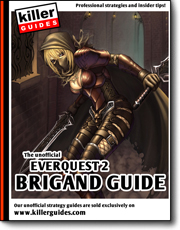
5.
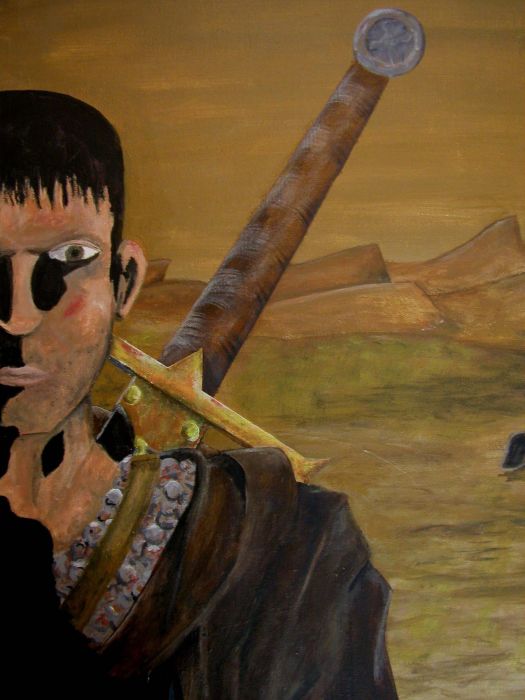
(Brigand)
4.
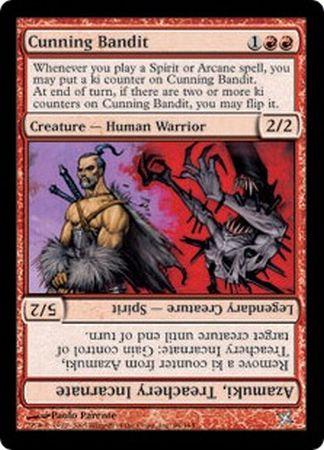
3.
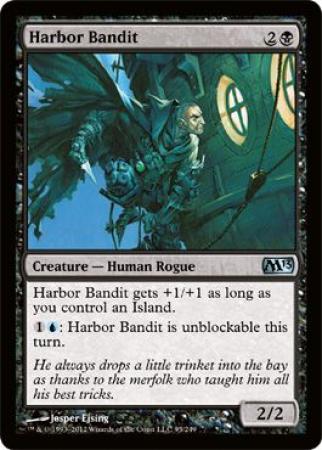
2.
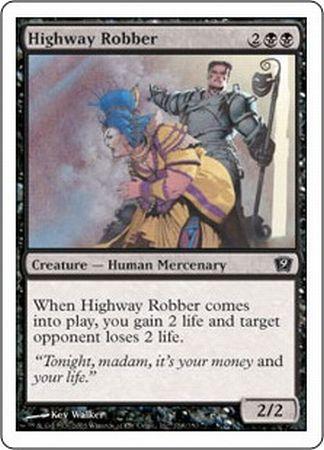
1.
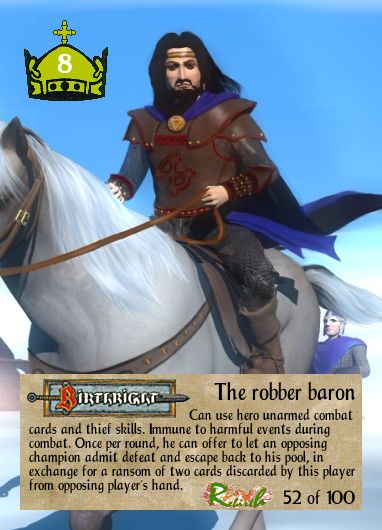
1. SUBCLASS =
2. SOCIAL CLASS MINIMUM =
3. ABILITY SCORE MINIMUMS
STRENGTH =
INTELLIGENCE =
WISDOM =
DEXTERITY =
CONSTITUTION =
CHARISMA =
COMELINESS =
PERCEPTION =
4. XP BONUS =
5. POSSIBLE RACES =
6. MAXIMUM LEVEL ATTAINABLE =
7. HIT DIE TYPE =
8. MAXIMUM NUMBER OF HIT DICE =
9. SPELL ABILITY =
10. ARMOR PERMITTED =
11. SHIELD PERMITTED =
12. WEAPONS PERMITTED =
13. OIL PERMITTED =
14. POISON PERMITTED =
15. ALIGNMENT =
16. STARTING MONEY =
17. WEAPON PROFICIENCIES =
18. NON-PROFICIENCY PENALTY =
19. NON-WEAPON PROFICIENCIES =
20. STARTING AGE =
21. COMBAT =
22. SAVING THROWS =
23. MAGIC ITEMS =
I have made slight revisions, here .. thanks for the comments.
Note that the statblock isn't meant to
cover everything, just like the statblocks in the MM don't cover everything.
As well, by no means is it meant to supplant
(include) the main class tables (The XP/Level/HP/Title table) for each
class.
The class statblock is intented to :
a) present information in an organized
fashion (an area where AD&D is rather lacking, at times)
b) by doing (a), it is easy to see 'at
a glance' where the 'holes' are in a character class (usu. social class,
proficiencies, etc.)
